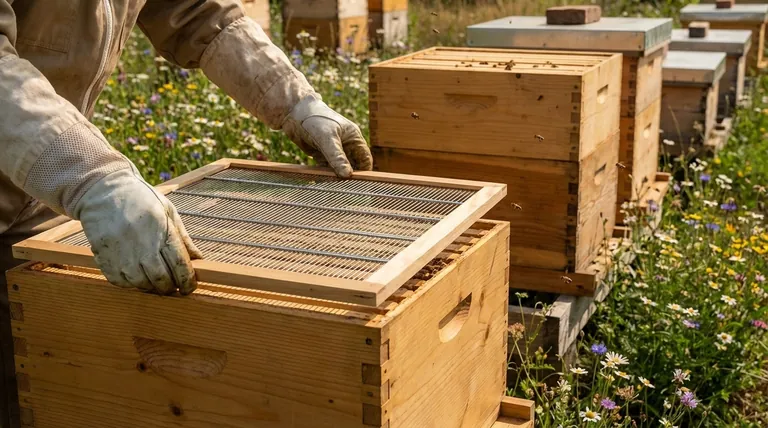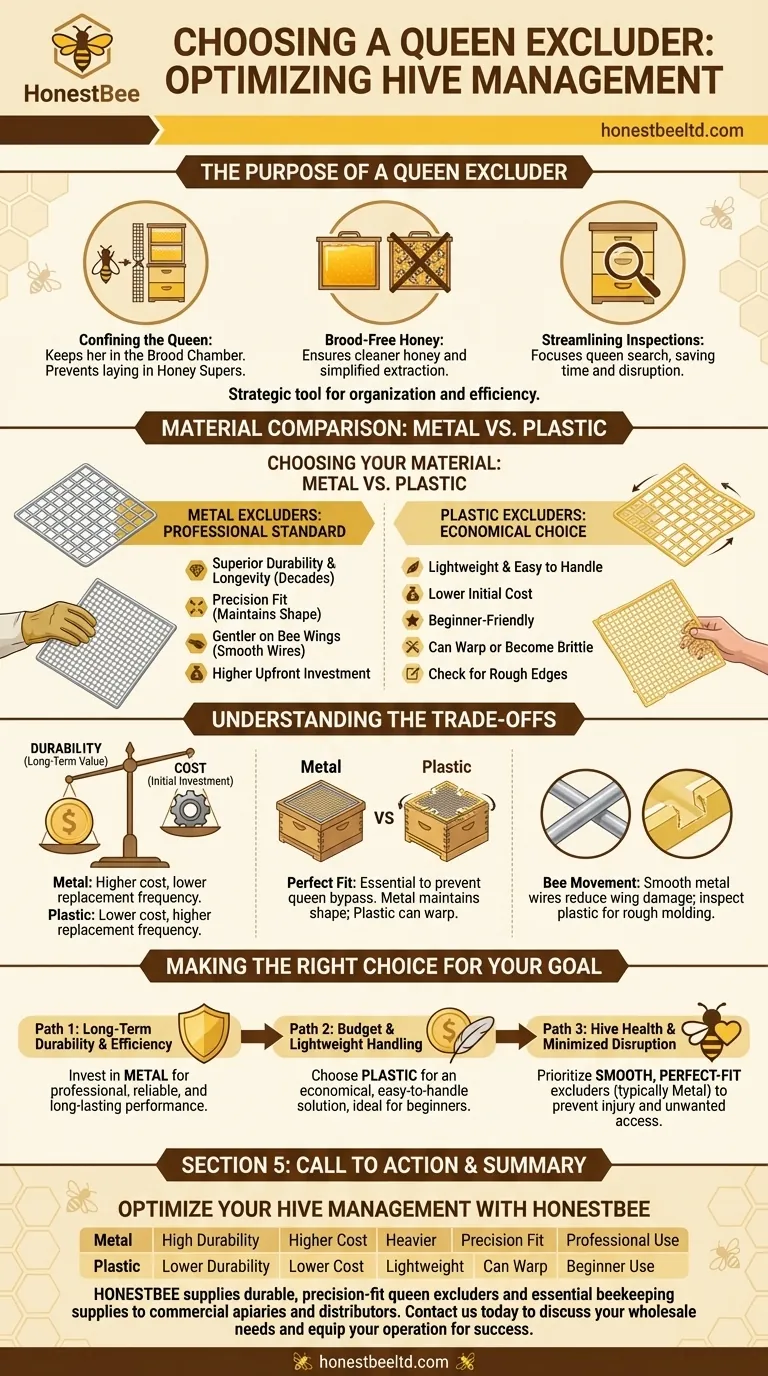The most critical factors when choosing a queen excluder are its material and its fit. Metal excluders offer superior durability and precision, while plastic excluders are a lightweight and economical alternative. The right choice depends entirely on your beekeeping goals, budget, and how you prioritize long-term performance versus initial cost.
Your choice of queen excluder is a strategic decision that directly impacts hive efficiency and your management workload. While metal is the professional standard for durability, plastic offers an accessible entry point. The key is selecting an excluder that fits perfectly and aligns with your beekeeping philosophy.

The Purpose of a Queen Excluder
Before comparing materials, it's essential to understand the strategic role an excluder plays in hive management. It is not simply a barrier; it is a tool for organization and efficiency.
### Confining the Queen to the Brood Chamber
A queen excluder is a perforated screen placed between the brood chamber (where the queen lays eggs) and the honey supers (where bees store surplus honey).
The slots are large enough for worker bees to pass through but too small for the larger queen, effectively confining her to the lower sections of the hive.
### Ensuring Brood-Free Honey
By keeping the queen out of the honey supers, you ensure these frames contain only honey. This results in cleaner honey, free from brood or shed larval skins.
This separation dramatically simplifies the honey extraction process, as you can remove entire supers without worrying about harming larvae or the queen.
### Streamlining Hive Inspections
When you need to find the queen—for health checks or requeening—an excluder significantly narrows your search area.
Instead of inspecting every frame in a tall hive, you know she is located in the one or two boxes of the brood chamber, saving you time and reducing disruption to the colony.
Choosing Your Material: Metal vs. Plastic
The primary decision you will make is the material. This choice has direct consequences for cost, durability, and ease of handling.
### Metal Excluders: The Professional Standard
Welded-wire metal excluders, made of galvanized or stainless steel, are widely considered the gold standard. Their rigid construction ensures the gaps remain uniform over time.
While they represent a higher upfront investment, their durability means they can last for decades. The smooth, rounded wires are also thought to be gentler on worker bees' wings as they pass through.
### Plastic Excluders: The Economical Choice
Plastic excluders are significantly cheaper and much lighter than their metal counterparts, making them easier to lift and handle.
This makes them an excellent choice for beginners, beekeepers on a tight budget, or those who manage a small number of hives. They are functional and get the job done effectively.
Understanding the Trade-offs
Choosing an excluder involves balancing competing priorities. What you gain in one area, you may sacrifice in another.
### The Durability vs. Cost Dilemma
The most apparent trade-off is longevity versus initial cost. A metal excluder may cost several times more than a plastic one but will likely outlast it many times over.
A plastic excluder is inexpensive to replace, but it can become brittle with sun exposure, warp under heat, or break if handled roughly.
### The Critical Importance of a Perfect Fit
An excluder is useless if it doesn't fit your hive boxes perfectly. Gaps between the excluder and the hive wall will allow the queen to bypass it, defeating its purpose.
Metal excluders are less prone to warping and maintain their shape, ensuring a snug fit year after year. Plastic can sometimes warp, creating gaps the queen can exploit.
### Impact on Bee Movement
The design of the openings matters. Any rough or sharp edges can potentially damage the wings of worker bees as they repeatedly pass through.
Properly manufactured metal excluders with smooth, welded wires are generally considered superior in this regard. When buying plastic, inspect it for any rough molding artifacts around the slots.
Making the Right Choice for Your Goal
Your priorities should guide your decision. There is no single "best" excluder, only the one that is best for your specific situation.
- If your primary focus is long-term durability and efficiency: Invest in a welded-wire metal excluder for its precision, longevity, and reliable performance.
- If your primary focus is budget and lightweight handling: A plastic excluder is a perfectly functional and economical choice, especially for new or small-scale beekeepers.
- If your primary focus is hive health and minimizing disruption: Ensure any excluder you choose has smooth openings and fits the hive box perfectly to prevent bee injury and unwanted queen access.
Ultimately, a well-made and properly installed excluder is a powerful tool for systematic hive management.
Summary Table:
| Factor | Metal Excluder | Plastic Excluder |
|---|---|---|
| Durability | High (Lasts decades) | Lower (Can warp/brittle) |
| Cost | Higher upfront investment | Lower initial cost |
| Weight | Heavier | Lightweight |
| Fit Precision | Maintains shape, snug fit | Can warp, creating gaps |
| Ideal For | Professional, long-term use | Beginners, budget-conscious |
Optimize your hive management with the right equipment.
HONESTBEE supplies durable, precision-fit queen excluders and other essential beekeeping supplies to commercial apiaries and distributors. Our wholesale-focused operations ensure you get professional-grade equipment that enhances hive efficiency and longevity.
Contact HONESTBEE today to discuss your wholesale needs and equip your operation for success.
Visual Guide

Related Products
- Premium Wood Framed Metal Wire Queen Bee Excluder
- Professional Plastic Queen Excluder for Modern Beekeeping
- High Performance Plastic Queen Excluder for Beekeeping and Apiary Management
- Plastic Queen Bee Excluder for Bee Hive Wholesale
- Wooden Queen Bee Excluder for Beekeeping
People Also Ask
- What is the primary function of a queen excluder? A Guide to Brood-Free Honey Harvesting
- What considerations should a beekeeper take into account when deciding whether to use an excluder?
- What is the purpose of a queen excluder? Achieve a Clean Honey Harvest & Organized Hive
- Where should a queen excluder be placed in a beehive? The Key to Hive Organization
- What are the advantages of using queen excluders? Boost Honey Production & Hive Management



















